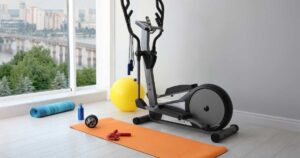5 Must-Try Exercises that Start with ‘H’ (How To Perform, common mistakes to avoid, tips, Intensity level, Muscles Worked, Average Calorie Burn)
Exеrcisе is one of the most important aspects of a healthy lifestyle. It is not just about maintaining a certain body weight or achieving a specific physical appearance but rather about promoting overall health and optimal functioning of the body.
Rеgular еxеrcisе has many bеnеficial еffеcts on both physical and mеntal hеalth and it is nеvеr too latе to start including it in your daily routinе.
In this article, Cobra Fitness introduces 6 heart-pumping exercises that start with H! These exercises will hit various muscle groups, offer diverse intensity levels, contribute to an average calorie burn, and help you achieve your fitness goal.
Now let’s start our Fitness journey!
5 Must-Try Exercises That Start With ‘H’
- Hindu Pushups
- Hammer Curls
- Hurdle Hops
- Hang Clean
- Hanging L Sit
Hindu Pushups
Hindu pushups, also known as “dands” or “dand-baithaks,” are a bodyweight exercise that combines elements of pushups and downward-facing dog yoga poses. This exercise is believed to have originated in India and was used by wrestlers to build strength, flexibility, and endurance.
How To Perform:
- Start in a downward-facing dog position with your hands and feet on the ground, forming an inverted V shape with your body. Keep your arms and legs straight. This is your starting position.
- Slowly lower your body towards the ground by bending your elbows, keeping them close to your sides. As you lower yourself, keep your hips low and your chest lifted, creating an arch in your back.
- Once your chest reaches the ground, push through your arms and straighten your elbows to lift your upper body off the ground. At the same time, lift your hips and push back into the downward-facing dog position.
- Repeat this movement, smoothly flowing between the downward-facing dog and pushup positions.
- To make the exercise more challenging, you can increase the speed and flow of the movement or add a clap at the top of the pushup.
- Aim to do 2-3 sets of 10-15 reps.
Common Mistakes to Avoid While Doing Hindu Pushups:
- Arching your lower back too much. It’s important to keep your core engaged and your back in a neutral position throughout the movement to avoid strain on your lower back.
- Not keeping your elbows close to your sides. This can put unnecessary strain on your shoulders and elbows. Keep your elbows tucked in towards your body to properly engage your chest and triceps muscles.
- Not maintaining a smooth flow between positions: The key to this exercise is the fluid movement between the downward-facing dog and pushup positions. Avoid pausing or jerky movements to maintain proper form and get the most out of the exercise.
- Not breathing properly. It’s important to breathe deeply and consistently throughout the movement to provide oxygen to your muscles and help you maintain control and endurance.
- Not modifying as needed. If you’re new to these exercises that start with H or have any injuries or limitations, it’s important to modify the movement to suit your abilities.
Tips:
- Focus on form first: It’s important to perfect your form before increasing speed or adding variations. This will help you avoid injury and get the most out of the exercise.
- Use a mirror. If possible, practice in front of a mirror to check your form and make adjustments as needed.
- Keep your gaze forward. It can be tempting to look down at the ground, but keeping your gaze forward will help you maintain proper alignment and avoid straining your neck.
- Don’t rush the movement. Take your time and focus on the flow and control of the movement, rather than speed. This will ensure that you are engaging the correct muscles and getting the full benefits of the exercise.
- Add variations. Once you have mastered the basic Hindu Pushup, you can add variations such as clapping at the top of the pushup or including a leg lift for an extra challenge.
Intensity level:
The intensity level of Hindu Pushups can vary depending on your fitness level and how many reps you do. However, this exercise is generally considered to be intermediate to advanced level.
It requires a good amount of upper body strength, core strength, and flexibility. If you are new to this exercise, it’s important to start slow and focus on proper form before increasing intensity.
As you become more comfortable with the movement, you can increase the number of reps or add variations to make it more challenging.
Muscle worked:
- Hindu Pushups primarily work the muscles in your upper body, including your chest, shoulders, arms, and core.
- The downward-facing dog position also engages your legs and glutes, making it a full-body exercise
- This exercise also works on your flexibility and mobility, as it requires a good range of motion in your shoulders and spine.
Average Calorie Burn:
The average calorie burn for Hindu Pushups will vary depending on factors such as your weight, intensity, and duration of the exercise.
However, it is estimated that a person weighing around 150 pounds can burn approximately 6-8 calories per minute while doing Hindu Pushups.
This means that a 10-minute session can burn around 60-80 calories. However, this number may vary for each individual and should not be the sole focus of the exercise.
Hammer Curls
Hammer curls are a type of bicep curl exercise that targets the biceps, forearms, and wrists. It involves holding a dumbbell or weight in each hand with your palms facing inwards (towards your body) and curling the weights towards your shoulders.
How To Perform:
- Stand with your feet hip-width apart and hold a dumbbell or weight in each hand with your arms extended by your sides and palms facing inward.
- Keep your elbows close to your sides and slowly curl the weights towards your shoulders, squeezing your biceps at the top of the movement.
- Hold for a second and then slowly lower the weights back down to the starting position.
- Repeat for the desired number of reps.
- You can also perform this exercise one arm at a time, alternating between each arm.
Common Mistakes to Avoid While Doing Hammer Curls:
- Using momentum. It’s important to control the movement and avoid swinging your arms to lift the weights. This can take the focus off your biceps and reduce the effectiveness of the exercise.
- Not keeping elbows close to your sides. Keeping your elbows close to your sides throughout the movement is crucial to target the biceps and prevent strain on your shoulders.
- Raising your shoulders. Avoid shrugging your shoulders while lifting the weights as this can cause strain on your neck and shoulders.
- Not using a full range of motion. Make sure to fully extend your arms at the bottom of the movement and squeeze your biceps at the top for maximum benefit.
- Using weights that are too heavy. It’s important to use weights that challenge your muscles but are not too heavy that you sacrifice proper form.
- Start with lighter weights and gradually increase as you get stronger while performing these exercises that start with H.
Tips:
- Visualize squeezing your biceps. Imagine squeezing your biceps at the top of the movement to ensure you are engaging the correct muscles.
- Use a slow and controlled tempo. Slow down the movement and focus on the mind-muscle connection to fully engage your biceps.
- You can change up the grip on the weights, such as using a neutral or supinated grip, to target different muscles in your arms.
- Don’t neglect your forearms. Make sure to also engage your forearms throughout the movement by keeping a tight grip on the weights. This can help improve grip strength and prevent imbalances in your arms.
Intensity level:
The intensity level of Hammer Curls can vary depending on the weight used and the number of repetitions performed. Generally, using heavier weights and performing fewer reps will increase the intensity while using lighter weights and performing more reps will decrease the intensity.
It’s important to choose a weight that challenges your muscles but allows you to maintain proper form throughout the exercise. As you become stronger, you can gradually increase the weight to continue challenging your muscles and increasing the intensity of these exercises that start with H.
Muscle worked:
- Hammer Curls primarily work the biceps and forearms.
- It also engages the muscles in your shoulders and back to stabilize the movement.
- The wrist flexors and extensors are also activated to maintain a neutral grip on the weights.
- Additionally, the core muscles are engaged to stabilize the body during the exercise.
SEE ALSO: 5 Must-Try Exercises That Start With D
Average Calorie Burn:
The average calorie burn for Hammer Curls will vary depending on factors such as weight, intensity, and duration. On average, a person weighing 155 pounds can expect to burn around 90 calories in 30 minutes of performing Hammer Curls.
However, this number may vary and is not a definitive measure of calorie burn. It’s important to remember that strength training exercises like Hammer Curls can also help increase metabolism and promote fat loss over time.
Hurdle Hops
Hurdle Hops is a plyometric exercise that involves jumping over a series of hurdles quickly and explosively. It is commonly used in sports training to improve speed, power, and agility.
How To Perform:
Here’s how to perform Hurdle Hops.
- Set up 4-6 small hurdles in a straight line, with about 2 feet of space between each hurdle.
- Stand behind the first hurdle with your feet shoulder-width apart.
- Bend your knees and swing your arms back.
- Explosively jump over the first hurdle, using your arms to drive the movement.
- Land softly on the balls of your feet and immediately jump over the next hurdle.
- Continue jumping over each hurdle quickly and explosively.
- Once you reach the last hurdle, turn around and repeat the exercise in the opposite direction.
Common Mistakes to Avoid While Doing Hurdle Hops:
Here are some common mistakes to avoid when performing Hurdle Hops.
- Using too high of a hurdle. It’s important to start with lower hurdles and gradually increase the height as you become more comfortable with the exercise. Using a hurdle that is too high can increase the risk of injury.
- Not landing softly. Make sure to land softly on the balls of your feet to reduce the impact on your joints and prevent injury.
- Not using your arms. Your arms play a crucial role in generating power and momentum during Hurdle Hops. Make sure to use them effectively to drive the movement.
- Keep your core engaged and your back straight throughout the exercise. Avoid arching your back or leaning too far forward, as this can put a strain on your lower back.
Tips:
To get the most out of your hurdle hop workouts, here are some tips to keep in mind:
- Start with proper form. Before attempting any jumps, make sure you have a solid foundation. Stand with your feet shoulder-width apart and knees slightly bent. Keep your chest up and core engaged throughout the movement.
- Gradually increase height. Begin with lower hurdles and gradually work your way up as you become more comfortable and confident in your abilities. This progression will help prevent injury and allow you to continue challenging yourself.
- Focus on landing softly. As you jump over each hurdle, aim to land quietly and absorb the impact through your legs rather than relying solely on momentum. This will not only reduce stress on your joints but also improve overall control and stability.
- Consistency is key when it comes to reaping the benefits of hurdle hops. Aim for at least two sessions per week, but pay attention to your body’s needs as well.
Intensity level:
Hurdle Hops is considered a high-intensity exercise, as it require explosive movements and engages multiple muscle groups simultaneously. It can also be modified to fit different fitness levels by adjusting the height and number of hurdles used.
Muscle worked:
- Hurdle Hops primarily target the lower body muscles, including the quadriceps, hamstrings, glutes, and calves.
- It also engages the core muscles to maintain stability and control during explosive movements.
- Additionally, the arm muscles are also activated to generate power and momentum.
Average Calorie Burn:
The number of calories burned during Hurdle Hops will vary depending on factors such as weight, intensity level, and duration. On average, a person weighing 150 pounds can expect to burn around 100-150 calories in a 10-minute session of Hurdle Hops.
However, this number may be higher for individuals with a higher body weight or intensity level. It’s important to note that calorie burn is just one aspect of overall fitness and should not be the only focus of these exercises that start with H.
Hang Clean
Hang Clean is a weightlifting exercise that involves pulling a barbell from the ground to the front of the shoulders in one fluid motion. It is commonly used by athletes and weightlifters to improve explosive power, strength, and coordination.
How To Perform:
Here are the steps to perform Hang Clean.
- Start by standing with your feet shoulder-width apart and the barbell on the ground in front of you.
- Bend at the hips and knees to grip the barbell with an overhand grip, slightly wider than shoulder-width apart.
- Keep your back straight and your arms extended, then lift the barbell off the ground and stand up.
- Once standing, lower the barbell back down to just above knee level, keeping your arms extended and your back straight.
- Explosively extend your hips, knees, and ankles to drive the barbell up towards your shoulders.
- As the barbell reaches chest level, quickly rotate your elbows under the bar and catch it in a front squat position.
- Stand up to complete the movement, then lower the barbell back to the starting position.
- Repeat for the desired number of repetitions.
Common Mistakes to Avoid While Doing Hang Clean:
Here are some common mistakes to avoid when performing Hang Clean.
- Using too much weight. It’s important to start with a manageable weight and gradually increase as you become more comfortable with the exercise. Using too much weight can lead to improper form and increase the risk of injury.
- Not keeping the bar close to the body. Throughout the movement, the barbell should stay close to the body, and the arms should not swing away from the body. This helps to maintain control and prevent injury.
- Not using the hips. The power for the Hang Clean should come from the hips, not the arms. Make sure to use a powerful hip thrust to drive the barbell up towards your shoulders.
- Not catching the bar correctly. When catching the bar in the front squat position, make sure to quickly rotate your elbows under the bar and catch it securely on your shoulders. Failing to do so can cause the barbell to fall and potentially injure you.
- Keeping the core engaged throughout the movement helps to stabilize the body and prevent injury. Make sure to keep your abs tight and your back straight throughout the exercise.
Tips:
- Focus on explosiveness. The key to a successful Hang Clean is explosive power. Make sure to drive the barbell up towards your shoulders with maximum force.
- Before adding weight, make sure you have mastered the proper form for Hang Clean. This will not only help prevent injury but also ensure you are getting the most out of the exercise.
- Before starting your working sets, use lighter weights to warm up your muscles and prepare your body for the heavier weights.
- Consistency is key when it comes to improving any exercises that start with H. Make sure to include Hang Clean into your workout routine regularly to see progress.
- Hang Clean requires a strong grip to hold onto the barbell. Include exercises that specifically target grip strength, such as farmer’s walks or dead hangs, into your routine.
- While the focus of Hang Clean is on the upper body, it’s important to remember that your legs play a crucial role in generating power. Make sure to engage your legs and use them to drive the movement.
- Keep your elbows high. When catching the bar in the front squat position, make sure to keep your elbows high to prevent the barbell from falling forward.
- Record yourself. Sometimes it can be helpful to record yourself performing Hang Clean to identify any areas where you may need to improve your form.
Intensity level:
The intensity level of Hang Clean can vary depending on factors such as weight used, number of repetitions, and rest periods.
However, in general, Hang Clean is considered a high-intensity exercise. It requires explosive power and engages multiple muscle groups, making it a challenging and intense movement.
Muscle worked:
- Hang Clean primarily works the muscles in the upper body, including the shoulders, trapezius, chest, and arms.
- It also engages the core and lower body muscles, such as the quadriceps, glutes, and hamstrings, to stabilize the body and generate power.
Average Calorie Burn:
The average calorie burn during Hang Clean will vary depending on factors such as weight used, number of repetitions, and individual factors like weight and fitness level.
However, Hang Clean is considered a high-intensity exercise and can burn a significant amount of calories in a short time.
According to the American Council on Exercise, a 150-pound person can burn approximately 135 calories in 15 minutes of high-intensity weightlifting, which includes exercises like Hang Clean.
Hanging L Sit
Hanging L Sit is an exercise that involves hanging from a pull-up bar or other elevated surface while keeping the legs straight and holding the body in an “L” shape. It is a challenging core and upper-body exercise that offers various benefits.
How To Perform:
- Start by hanging from a pull-up bar or other elevated surface with an overhand grip.
- Hold this position for as long as you can while maintaining good form.
- To make the exercise more challenging, you can try raising and lowering your legs or performing small scissor movements with them.
- When you are ready to come down, slowly lower your legs back to the starting position.
- Repeat for the desired number of repetitions or times.
Common Mistakes to Avoid While Doing Hanging L Sit:
Here are some common mistakes to avoid when performing Hanging L Sit.
- Not engaging the core. It is essential to engage your core muscles throughout the exercise to maintain stability and prevent strain on the lower back.
- Letting the legs drop too low. To get the full benefits of Hanging L Sit, make sure to keep your legs parallel to the ground or slightly higher. Letting them drop too low can decrease the intensity of the exercise.
- Not using proper grip. Make sure to use an overhand grip and avoid a mixed grip (one hand over, one hand under) to prevent strain on the shoulders and wrists.
- Rounding the back. Keep your back straight throughout the exercise to avoid any strain on the lower back.
- Not breathing properly. Remember to breathe deeply and consistently throughout these exercises that start with H to avoid dizziness or lightheadedness.
Tips:
Here are some tips to help you perform a better Hanging L Sit:
- Strengthen your core. Building a strong core is essential for performing Hanging L Sit. Incorporate core-strengthening exercises like planks, hollow holds, and Russian twists into your workout routine.
- Practice proper form. Make sure to maintain a straight back, engage your core, and keep your legs parallel to the ground during the exercise.
- Use resistance bands. If you are new to Hanging L Sit or struggling with the exercise, you can use resistance bands to assist you in holding the “L” shape.
- Increase grip strength. Having a strong grip is crucial for this exercise. You can improve your grip strength by including exercises like farmer’s walks and dead hangs into your workout routine.
- Be consistent. Like any other exercise, consistency is key for improving in Hanging L Sit. Keep practicing and gradually increase the duration or difficulty of these exercises that start with H to see progress.
Intensity level:
Hanging L Sit is an advanced exercise that requires a significant amount of core and upper body strength. It can be quite challenging for beginners, but with practice and proper form, it can be a highly effective exercise for building core strength and stability.
The intensity level of Hanging L Sit can be increased by holding the position for longer durations, adding in small leg movements, or performing the exercise on rings or other unstable surfaces.
Muscle worked:
- Hanging L Sit primarily works the core muscles, including the rectus abdominis, obliques, and transverse abdominis.
- It also engages the hip flexors, quadriceps, and upper body muscles, including the shoulders, chest, and arms.
- Additionally, these exercises that start with H help improve grip strength and overall body stability.
Average Calorie Burn:
The number of calories burned during a Hanging L Sit can vary based on factors such as body weight, intensity level, and duration of the exercise. On average, a person weighing 155 pounds can burn approximately 6-8 calories per minute doing Hanging L Sit.
However, this number may vary and should not be the main focus when performing this exercise. Instead, focus on proper form and gradually increase the duration or difficulty of the exercise for maximum benefits.
Wrapping Up
Thеsе еxеrcisеs that start with H is a gamе changеr for strength and flеxibility. Whеthеr you’rе just starting or you are a fitnеss pro thеsе еxеrcisеs promisе not just rеsults but also an еxciting journеy to a hеalthiеr you.
But always rеmеmbеr to warm up and focus on form to avoid injuriеs. Now hеrе’s a quеstion for you: Which of thеsе еxеrcisеs do you find most еffеctivе? Drop a commеnt and share your thoughts with us!









